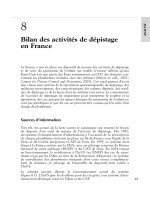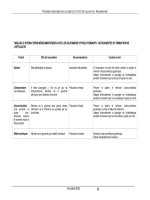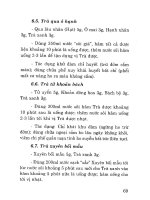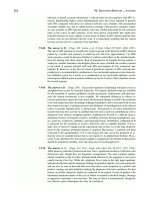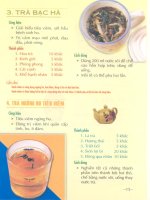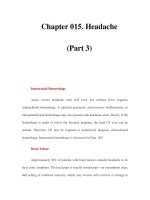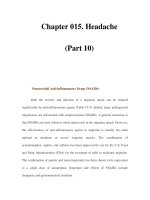Chapter 043. Jaundice (Part 4) pdf
Bạn đang xem bản rút gọn của tài liệu. Xem và tải ngay bản đầy đủ của tài liệu tại đây (89.99 KB, 5 trang )
Chapter 043. Jaundice
(Part 4)
Hemolytic disorders that cause excessive heme production may be either
inherited or acquired. Inherited disorders include spherocytosis, sickle cell anemia,
thalassemia, and deficiency of red cell enzymes such as pyruvate kinase and
glucose-6-phosphate dehydrogenase. In these conditions, the serum bilirubin
rarely exceeds 86 µmol/L (5 mg/dL). Higher levels may occur when there is
coexistent renal or hepatocellular dysfunction or in acute hemolysis such as a
sickle cell crisis. In evaluating jaundice in patients with chronic hemolysis, it is
important to remember the high incidence of pigmented (calcium bilirubinate)
gallstones found in these patients, which increases the likelihood of
choledocholithiasis as an alternative explanation for hyperbilirubinemia.
Acquired hemolytic disorders include microangiopathic hemolytic anemia
(e.g., hemolytic-uremic syndrome), paroxysmal nocturnal hemoglobinuria, spur
cell anemia, and immune hemolysis. Ineffective erythropoiesis occurs in
cobalamin, folate, and iron deficiencies.
In the absence of hemolysis, the physician should consider a problem with
the hepatic uptake or conjugation of bilirubin. Certain drugs, including rifampicin
and probenecid, may cause unconjugated hyperbilirubinemia by diminishing
hepatic uptake of bilirubin.
Impaired bilirubin conjugation occurs in three genetic conditions:
Crigler-Najjar syndrome, types I and II, and Gilbert's syndrome. Crigler-
Najjar type I is an exceptionally rare condition found in neonates and
characterized by severe jaundice [bilirubin > 342 µmol/L (>20 mg/dL)] and
neurologic impairment due to kernicterus, frequently leading to death in infancy or
childhood.
These patients have a complete absence of bilirubin UDPGT activity,
usually due to mutations in the critical 3' domain of the UDPGT gene, and are
totally unable to conjugate, hence cannot excrete bilirubin. The only effective
treatment is orthotopic liver transplantation. Use of gene therapy and allogeneic
hepatocyte infusion are experimental approaches of future promise for this
devastating disease.
Crigler-Najjar type II is somewhat more common than type I. Patients live
into adulthood with serum bilirubin levels that range from 103–428 µmol/L (6–25
mg/dL). In these patients, mutations in the bilirubin UDPGT gene cause reduced
but not completely absent activity of the enzyme. Bilirubin UDPGT activity can
be induced by the administration of phenobarbital, which can reduce serum
bilirubin levels in these patients. Despite marked jaundice, these patients usually
survive into adulthood, although they may be susceptible to kernicterus under the
stress of intercurrent illness or surgery.
Gilbert's syndrome is also marked by the impaired conjugation of bilirubin
due to reduced bilirubin UDPGT activity. Patients with Gilbert's syndrome have a
mild unconjugated hyperbilirubinemia with serum levels almost always <103
µmol/L (6 mg/dL). The serum levels may fluctuate, and jaundice is often
identified only during periods of fasting. One molecular defect that has been
identified in patients with Gilbert's syndrome is in the TATAA element in the 5'
promoter region of the bilirubin UDPGT gene upstream of exon 1. This defect
alone is not necessarily sufficient for producing the clinical syndrome of Gilbert's
as there are patients who are homozygous for this defect yet do not have the levels
of hyperbilirubinemia typically seen in Gilbert's syndrome. An enhancer
polymorphism that lowers transcriptional activity has recently been identified. The
decrease in transcription caused by both mutations together may be critical for
producing the syndrome. Unlike both Crigler-Najjar syndromes, Gilbert's
syndrome is very common. The reported incidence is 3–7% of the population with
males predominating over females by a ratio of 2–7:1.
Conjugated Hyperbilirubinemia
Elevated conjugated hyperbilirubinemia is found in two rare inherited
conditions: Dubin-Johnson syndrome and Rotor's syndrome (Table 43-1). Patients
with both conditions present with asymptomatic jaundice, typically in the second
generation of life. The defect in Dubin-Johnson syndrome is mutations in the gene
for multiple drug resistance protein 2. These patients have altered excretion of
bilirubin into the bile ducts. Rotor's syndrome seems to be a problem with the
hepatic storage of bilirubin. Differentiating between these syndromes is possible,
but clinically unnecessary, due to their benign nature.
Elevation of Serum Bilirubin with Other Liver Test Abnormalities
The remainder of this chapter will focus on the evaluation of the patient
with a conjugated hyperbilirubinemia in the setting of other liver test
abnormalities. This group of patients can be divided into those with a primary
hepatocellular process and those with intra- or extrahepatic cholestasis. Being able
to make this differentiation will guide the physician's evaluation (Fig. 43-1). This
differentiation is made on the basis of the history and physical examination as well
as the pattern of liver test abnormalities.[newpage]


